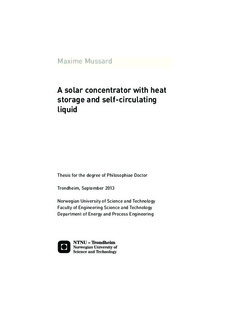| dc.contributor.author | Mussard, Maxime | nb_NO |
| dc.date.accessioned | 2014-12-19T11:50:38Z | |
| dc.date.available | 2014-12-19T11:50:38Z | |
| dc.date.created | 2013-09-06 | nb_NO |
| dc.date.issued | 2013 | nb_NO |
| dc.identifier | 646128 | nb_NO |
| dc.identifier.isbn | 978-82-471-4437-4 (printed ver.) | nb_NO |
| dc.identifier.isbn | 978-82-471-4438-1 (electronic ver.) | nb_NO |
| dc.identifier.uri | http://hdl.handle.net/11250/235100 | |
| dc.description.abstract | The main objective of this thesis is to design and test a solar concentrating collector with heat storage for domestic applications, mainly solar cooking. The system must be cheap, robust, easy to use and maintain, and non-hazardous. The system must be able to store energy over 200◦C to enable cooking, baking and frying. The heat collection is performed with a parabolic trough focusing the energy on a focal line where the absorber stands, the whole system is driven with a solar tracker.
The first task is to find relevant materials for heat storage. After investigation, latent heat materials show a better potential for this application, especially for their ability to store a lot of energy at constant temperature. The influence of solar tracking inaccuracy is investigated as well, and shows that by chosing a large absorber, it is possible to both reduce the influence of these inaccuracies and of the solar angle.
The concept of self-circulation has numerous advantages, such as the absence of a pumping system and the self-regulation of the temperature. This concept is then tested with a first prototype to ensure that it is suitable for our objectives. The test shows a great ability for thermal oil to transfer energy from the collector to a heat storage placed above using the self-circulation principle. The next objective is then to optimize the heat transfer into the absorber. After comparing with electrical heating the performance of two different storages coupled with the same self-circulating loop, it appears that a storage with a larger volume of oil is more efficient than an aluminum-based storage. Coupled with latent heat materials, the oil-based storage is then the basis for the following tests.
Experiments are conducted outdoors to test the charging of the system with the sun. Absorbers with and without insulation are tested, and as expected the insulation (air layer) around the absorber is necessary to reach quickly high temperatures. The system proves to be good enough to charge a storage in one sunny day starting from ambient temperature. The energy stored is large enough to provide cooking energy for two people. After charging, heat extraction experiments are conducted. The system shows great abilities for frying but boiling water takes time. After testing with a flat plate, it appears that the low quality of the contact between the top plate and the cooking pan contributes to the long cooking time. By improving the flatness of the top of the heat storage, boiling water can be performed in a reasonable time, competitive compared to traditional cookings devices or commercialized direct solar cookers. A final test was started with an evacuated tube around the absorber, and simulations on the upscaling of the storage are made to conclude on the potential of this concept. The measurements have successfully been compared with a dynamic system model. The computational model was used for upscaling analysis. | nb_NO |
| dc.language | eng | nb_NO |
| dc.publisher | Norges teknisk-naturvitenskapelige universitet, Fakultet for ingeniørvitenskap og teknologi, Institutt for energi- og prosessteknikk | nb_NO |
| dc.relation.ispartofseries | Doktoravhandlinger ved NTNU, 1503-8181; 2013:164 | nb_NO |
| dc.relation.haspart | Mussard, Maxime; Nydal, Ole Jørgen. Assessments of the thermal storage potential of sensible and latent heat-based systems for solar domestic applications. Proceedings of the 7th International Renewable Energy Storage Conference and Exhibition, 2012. | nb_NO |
| dc.relation.haspart | Mussard, Maxime; Nydal, Ole Jørgen. Influence of solar tracking inaccuracy and sun rays modeling on the efficiency of a small-scale parabolic trough. Energy Procedia. (ISSN 1876-6102), 2013. | nb_NO |
| dc.relation.haspart | Mussard, Maxime; Vaujany, Erwan; Nydal, Ole Jørgen. Heating of an oil-based heat storage with a low-cost small-scale solar parabolic trough. Proceedings of the EuroSun2012, 2012. | nb_NO |
| dc.relation.haspart | Mussard, Maxime; Nydal, Ole Jorgen. Comparison of oil and aluminum-based heat storage charged with a small-scale solar parabolic trough. Applied Thermal Engineering. (ISSN 1359-4311). 58(1-2): 146-154, 2013. <a href='http://dx.doi.org/10.1016/j.applthermaleng.2013.03.059'>10.1016/j.applthermaleng.2013.03.059</a>. | nb_NO |
| dc.relation.haspart | Mussard, Maxime; Nydal, Ole Jørgen. Charging of a heat storage coupled with a low-cost small-scale solar parabolic trough for cooking purposes. Solar Energy. 95: 144-154, 2013. <a href='http://dx.doi.org/10.1016/j.applthermaleng.2013.03.059'>10.1016/j.applthermaleng.2013.03.059</a>. | nb_NO |
| dc.relation.haspart | Mussard, Maxime; Gueno, Alexandre; Nydal, Ole Jørgen. Experimental study of solar cooking using heat storage in comparison with direct heating. Solar Energy. (ISSN 0038-092X), 2013. | nb_NO |
| dc.relation.haspart | Mussard, Maxime. Solar cooker with heat storage at high temperature: charging experiments and simulations. Energy Procedia. (ISSN 1876-6102), 2013. | nb_NO |
| dc.title | A solar concentrator with heat storage and self-circulating liquid | nb_NO |
| dc.type | Doctoral thesis | nb_NO |
| dc.contributor.department | Norges teknisk-naturvitenskapelige universitet, Fakultet for ingeniørvitenskap og teknologi, Institutt for energi- og prosessteknikk | nb_NO |
| dc.description.degree | PhD i energi- og prosessteknikk | nb_NO |
| dc.description.degree | PhD in Energy and Process Engineering | en_GB |

